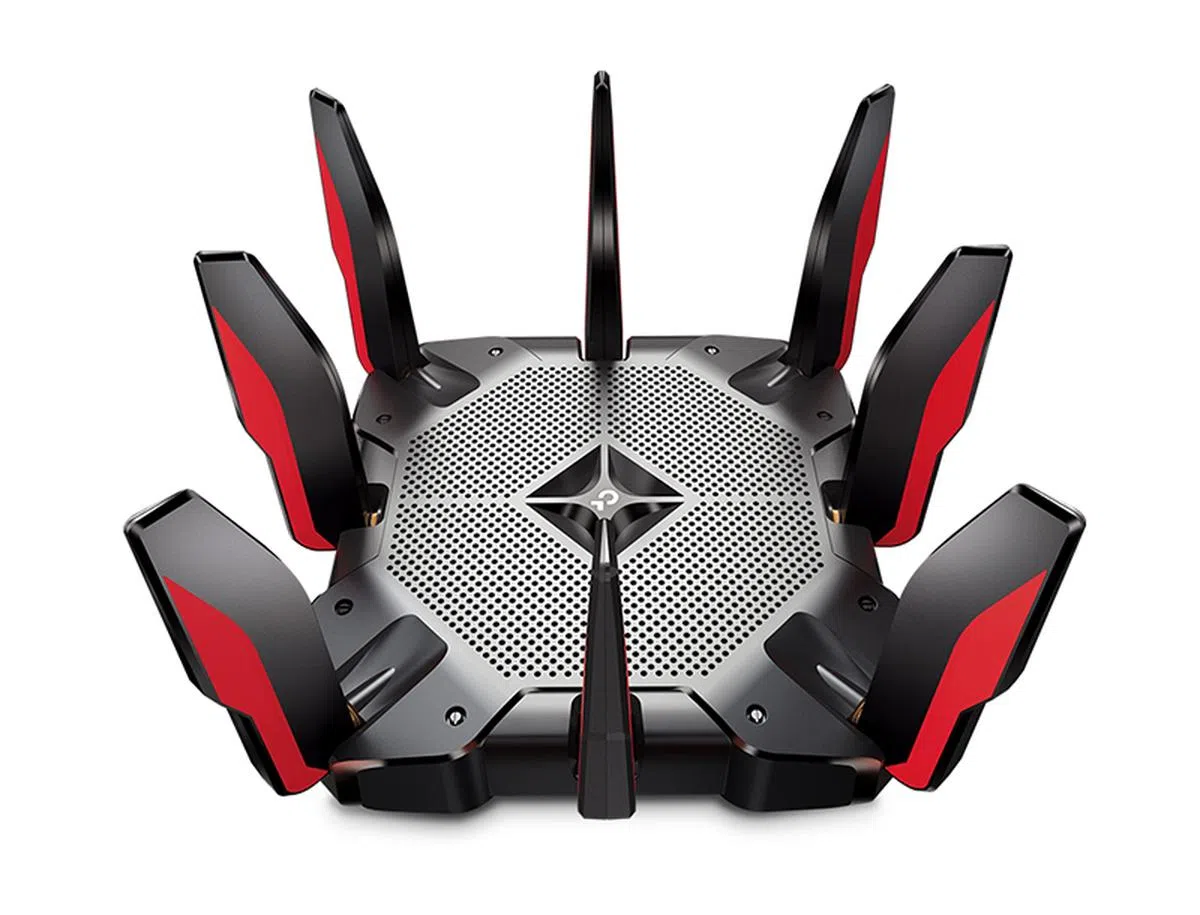Wi-Fi 6 AX-11000 router shootout: ASUS vs. Netgear vs. TP-Link
Find out which is the best tri-band Wi-Fi 6 AX11000-class router in this mega shootout.
By Kenny Yeo -
Note: This shootout was first published on 16 March 2020.
What’s Wi-Fi 6?
Before we begin, here’s a quick overview of Wi-Fi 6. If you didn’t already know, Wi-Fi 6 is the next big wireless networking standard.
It aims to improve Wi-Fi by making routers more efficient. The problem with routers today isn’t necessarily speed – Wi-Fi 5 routers are already capable of data transfer rates in excess of 1Gbps. Rather, it’s that they are inefficient at communicating with multiple client devices. Wi-Fi 6 rectifies this problem by leveraging on a piece called ODFMA (orthogonal frequency division multiple access). This chops up a Wi-Fi channel into hundreds of smaller sub-channels, allowing a single Wi-Fi channel to accommodate multiple clients. To use a motorway analogy, think of Wi-Fi 6 as a wider highway. The speed limit hasn’t been drastically increased but the highway has been widened considerably.

The big aim of Wi-Fi 6 is to improve overall network efficiency thereby improving overall performance and speed of all connected devices (Image source: Intel)
At any rate, to read more about Wi-Fi 6, check out the guides below:
- Wi-Fi has been renamed, but is it really easier to understand?
- The newbie’s guide to 802.11ax: The next big wireless standard
In this shootout, we will be focusing on the fastest Wi-Fi 6 routers that are currently available. These are tri-band routers that support a maximum data transfer rate of 11,000Mbps. These routers achieve this remarkable performance by transmitting 4 streams on all three frequency bands. The 2.4GHz frequency band supports a maximum data transfer rate of 1,148Mbps while each of the 5GHz frequency bands can manage up to 4,804Mbps. Let’s take a look at our contenders.
ASUS ROG Rapture GT-AX11000

The ROG Rapture GT-AX11000 is ASUS' flagship gaming router.
We begin with the ASUS ROG Rapture GT-AX11000. This router is one of the older routers in this shootout. It was first unveiled at Computex 2018 and then it was finally ready late last year.
The design is distinctive but instantly recognisable as the ROG GT-AX11000 is almost indistinguishable from ASUS’ last flagship router - the ROG Rapture GT-AC5300. The only big change in design is that the ROG logo on the router now lights up and supports Aura RGB lighting with different lighting modes like breathing, colour cycle, and comet (check out our video of it in action here). Admittedly, the overall aesthetic is quite garish but then the concession can be that the ROG GT-AX11000 was designed with gamers in mind.

What's a gaming router without customisable RGB lights?
Handy LED status indicators make it easy for users to troubleshoot the router in case something goes wrong, and on the left side of the routers are three buttons for WPS setup, activate/deactivate Wi-Fi, and ROG Boost. ROG Boost is essentially a shortcut button that can be mapped to instantly activate or deactivate things like your Aura RGB or QoS settings.

Handy LED status indicators let you know if your connection goes down.

The only thing it lacks is another four Gigabit Ethernet ports.
Round the back of the router are all the ports. There are two USB 3.0 ports, which are handy for file and print-sharing. There’s also the usual lone Gigabit Ethernet WAN port and four Gigabit Ethernet LAN ports. Four is a little stingy, especially when you consider the old GT-AC5300 came with no less than 8 LAN ports. If it’s any consolation, the GT-AX11000 also comes with an additional 2.5Gbps LAN port, which can be handy if you have access to very high-speed fibre. And even though it isn’t explicitly stated, the ROG GT-AX11000 supports link aggregation on the first two LAN ports.
The ROG GT-AX11000 is managed by the ROG Gaming Center, which comes with gamer-centric features that are not found on non-ROG ASUS routers. And as you can see from the screen-caps, it’s very red and has a mood that’s fitting for a gaming router. The ROG GT-AX11000 has a ton of features but three worth mentioning are Game Boost, Game Radar, and Game Profile.

The router management interface has features designed for gamers. The main screen instantly shows network traffic, ping times, and ping deviation times.
Let’s go through them now. Game Boost is an adaptive QoS technology that actively prioritises gaming data packets. Game Radar quickly shows game server pings time for a number of games, including Diablo 3, DOTA 2, League of Legends, Overwatch, and many more. And finally, Game Profile, provides port forwarding presets for popular games like Diablo 3, CS:GO, DOTA 2, Call of Duty, and more.
Finally, like all other ROG routers, the ROG GT-AX11000 comes with a complimentary subscription to wtfast. It claims to be a private gamers’ network that provides the shortest connection possible to popular game servers, thereby minimising latency and ping times.

The parental control features are surprisingly robust. Presumably to help parents rein in their kids' gaming time.
These are all features that are not found on its rivals. In addition, it's also the only router to support Dynamic Frequency Selection (DFS), which lets the router use 5GHz channels that are normally reserved for use by government services. You can read more about DFS here.
Parents with children will be happy to learn that the ROG Rapture GT-AX110000 has, by far, the most robust and flexible parental control features. Unlike its rivals which have certain restrictions, parents using the ROG Rapture GT-AX11000 have the freedom to block out specific hourly blocks each day.
Furthermore, the ROG Rapture GT-AX11000 also supports AiMesh, an ASUS technology that enables multiple ASUS routers to come together to create a mesh network. This is particularly handy if you are upgrading from another ASUS router that’s AiMesh-compatible since you can continue to use it to increase your Wi-Fi coverage. We've also tested this function previously and it worked quite well.

The ASUS Router app is the most full-featured.
And like any high-end router today, the ROG Rapture GT-AX11000 can be remotely managed and controlled using the ASUS router app. It’s easily the most powerful and full-featured router app and can be used to control and manage just all about all aspects of the router. You can use the app to quickly share Wi-Fi passwords, remotely change QoS settings, change parental control limits, and more.
Netgear Nighthawk Tri-band AX12 12-Stream Wi-Fi 6 router

The Netgear Nighthawk RAX200 is arguably the best looking of the trio.
The Netgear Nighthawk Tri-band AX12 12-Stream Wi-Fi 6 router (RAX200) was one of the first Wi-Fi 6 routers to be commercially available and it’s easily the most refined looking. Sure, the two large antennae are a little outlandish but I’m sure you’ll agree its more restrained than the ASUS and TP-Link routers. To my eyes, it reminds me of the Imperial Shuttle from Star Wars. Like the ASUS ROG Rapture GT-AX11000, the Netgear Nighthawk RAX200 is a large and wide router. The antennae are also very prominent so you’ll need to make sure there’s space for it.

The Netgear Nighthawk RAX200 has a fan to help keep the router cool.
Looking around, there’s a strip of LED status indicators on the top of the router, which is handy for troubleshooting if your connection goes down. Also, peeking through the grille, one can also a fan. Fortunately, the fan is remarkably quiet and doesn’t draw attention to itself. There are also two buttons on the top panel – one turns the Wi-Fi radio on and off while the second is for WPS setups.

All of the ports are located behind the router.

The Netgear Nighthawk RAX200 supports port aggregation for both WAN and LAN ports. Pity it only has four LAN ports.
Round the back are all the ports. There are two USB-A USB 3.0 ports which can be used for print and file-sharing, a single Gigabit Ethernet WAN port, and four Gigabit LAN ports. There’s also a single Multi-Gig Ethernet WAN port that supports speeds of up to 2.5Gbps. To enable users to maximise the fast wireless speeds, the Netgear Nighthawk RAX200 supports port aggregation. You can use the WAN port and one of the LAN port to create a 2Gbps WAN connection. You can also use two of the LAN ports to create a single 2Gbps LAN connection. The flexibility is much welcomed but I think most users would also like to see more than four LAN ports so that they can connect more devices to the router.

The Netgear Nighthawk RAX200's router interface is the cleanest.
The Netgear Nighthawk RAX200’s router management interface is clean but also powerful. For most users, the Basic menu would suffice. It lets you set up your wireless networks, QoS, and even ReadySHARE, Netgear’s file and printer sharing feature. The Advanced menu is for those who want to tinker around with settings like Wi-Fi transmit power, disable/enable Wi-Fi 6, port aggregation, remote file sharing, and VPN connections.
The biggest letdown with the Netgear Nighthawk RAX200’s router management interface is its clumsy parental controls system. Unlike its rivals, it’s a blanket setting that applies to all connected devices. Parents, what this means if you want to prevent your children from using the Internet from say, 9pm to 9am, every device in the household will be blocked.
Furthermore, you can only set a single start and end time. This means you can only specify a single block of time every day where Internet access is restricted. You can’t specify two periods of time like 8am to 10am in the morning and 8pm to 12pm at night. It has to be one block a day.
You have the option to block specific devices, but that option doesn’t allow for scheduling. So if you want to block your kid’s iPad, you’ll have to go into the settings to do it and then return when you want to restore connectivity.

The Nighthawk app is very basic.
You can also remotely manage the Netgear Nighthawk RAX200 using the Nighthawk app. But the app itself is pretty basic, you can manage your wireless settings, share Wi-Fi passwords, do a speed test, and see what devices are connected, and that’s about it.
TP-Link Archer AX11000

The TP-Link Archer AX11000 is easily the most outlandish and garish looking of the trio.
The Archer AX11000 is TP-Link’s current flagship router and only the second router in their nascent lineup of gaming routers. It’s also the most garish looking of the trio. As if 8 external antennae weren’t enough, the antennae themselves are somewhat bulbous and have bright red accents. To my eyes, it looks as if unspeakable things have sprouted out of the router. Of course, the argument could be made that this is a gaming router and therefore it must look as such, but insofar as looks are concerned, I think it’s safe to say that ASUS did a far better job at nailing the “gamer” look than TP-Link.

The Archer AX11000 is one of the few routers with a USB-C port.
Fortunately, the Archer AX11000 redeems itself in other ways. For a start, it’s the only router to have a USB-C port, which can come in handy if you want to attach a USB-C storage device to the router for file-sharing. It also has another USB-A USB 3.0 port. It’s also the only router to come with 8 Gigabit Ethernet ports. It may seem overkill but if you think about it, if you have a desktop system, a gaming console, a TV, and a NAS, that’s four ports accounted for already. Handily, two of the LAN ports also support link aggregation, so you can connect a super-fast 2Gbps connection if you have compatible devices. And, speaking of fast connections, the single WAN port supports speeds of up to 2.5Gbps.

The Archer AX11000 has eight Gigabit Ethernet LAN ports, with two of them supporting link aggregation.
Elsewhere on the side of the router are three buttons. One for WPS setups and another to activate and deactivate the Wi-Fi radios. The last button turns the LED light off, which can be handy if you happen to place the router in your bedroom and sleep next to it.

The Archer AX11000's interface is very red but thankfully easy to navigate and use.
The Archer AX11000’s management interface resembles that of the ASUS’ in that it’s also very red and it has features that were designed for gamers. The main screen shows the number of clients connected, real-time traffic usage, and lets you quickly run a speed test to check your connection speed.
A couple of features worth mention is the Game Accelerator, which TP-Link says automatically detects and optimises gaming traffic – kind of like a more advanced QoS. Then there’s Game Protector, which consists of two components. The first is a built-in anti-virus feature powered by Trend Micro, and the second is parental controls. Overall, it's an interface that is easy to navigate and use.

One nifty feature of this router is the ability to set time limits for individual devices.
The parental controls feature is better than Netgear’s but less flexible than ASUS’. You can assign profiles and set time limits for individual devices. The latter is quite handy since you can assign, say, two hours a day to your child and have your child manage his or her own time. However, one shortcoming of the Archer AX11000’s parental control is that you can only block out Internet access for a single time period each day. This means you can’t set separate homework times or bedtimes for your child.

The Tether app lets you remotely manage the router.
The Archer AX11000 can also be remotely managed using TP-Link’s Tether app. It’s more slightly more powerful than Netgear’s Nighthawk app but it was no match for ASUS’ Router app. Through the Tether app, users can run speed tests and also manage things like wireless settings, QoS settings, and anti-virus settings.
Test Setup
To test these routers, we are using our standard test setup which consists of two notebooks, one acting as a host machine and the other as a client device. The router acts as a gateway. For systems where manual settings are possible, a channel bandwidth of 160MHz is selected where applicable.
Since these are Wi-Fi 6 routers, we needed a Wi-Fi 6 client device. For that, we chose the newest HP Spectre x360 13, which is also the winner of our Best Ultraportable Notebook category in the 2020 Tech Awards.

Here's a graphical representation of our test setup.
To evaluate, we will be measuring the time and calculating the speed achieved when transferring a 1GB zip file. We will do multiple tests with different setups and different distances to simulate use around a typical 5-room apartment.
The router was placed in the living room and we repeated the test from a number of locations in the flat, starting from the closest to the router to the farthest.
Here are the locations and the rough ranges that they represent:
- Living room (2 metres)
- Bedroom 1 (4 metres)
- Bedroom 2 (7 metres)
- Master Bedroom (10 metres)
- Master Toilet (10 metres, behind two closed doors)
Performance analysis


Conclusion

The Netgear RAX200 is fast but it's also really pricey.
The Netgear RAX200 is quite clearly the fastest router. Though performance tapered off at the farthest ranges, its showing was very strong particularly around the living room and the first two bedrooms (up to around 7 metres). It could be as much as 15% faster than its rivals which is impressive. I also think it has the best design. Looks are subjective but it’s hard to argue that, out of the three, the RAX200 looks the most elegant and versatile. It also has some nice and useful features like port aggregation, a 2.5G WAN port, and support for Alexa and Google Assistant.
However, there are a couple things that count against it. To start, its router management interface is quite clumsy and not as refined. There are many advanced settings but they are hidden. Parents should also take note that it has very limited parental controls settings. But most of all, the RAX200 is very pricey. At S$899, its S$200 pricier than the ASUS ROG Rapture GT-AX11000 and S$290 more than the TP-Link Archer AX11000. The case can be made for the RAX200’s class-leading performance, but it’s not as if its rivals were terribly slow or comprehensively outclassed in this respect.

The TP-Link Archer AX11000 is the most affordable but it also looks garish and it was the slowest.
The TP-Link Archer AX11000 is surely the most garish looking of the trio. Some folks might find it attractive but I think most will find it a bit too much. Nevertheless, it stands out for being the only router with 8 Gigabit Ethernet LAN ports. For readers who have many other devices to connect to – NAS, TV set-top boxes, media streamers, music streamers – the choice is quite clear. Happily, the Archer AX11000 also works with Alexa and it’s the most affordable router by a good margin.
On the flip side, the Archer AX11000 doesn’t quite have as many or as useful gamer features like as the ROG Rapture GT-AX11000. Also, its parental control features are limited and restrictive. But most of all, the strongest case against it is its performance. Download speeds are quite decent but its upload speeds are noticeably slower than its competitors. It could be as much as 25% slower which is too great a difference to be ignored.

The ASUS ROG Rapture GT-AX11000 is the best all-round performer. It also helps that it isn't the most expensive.
The best all-round performer and the winner of this shootout is the ASUS ROG GT-AX11000. It has a terrific blend of performance, features, and price. It might not be the outright performance champ, but its upload and download speeds were both very decent across all ranges. But what’s most impressive about the ROG Rapture GT-AX11000 is its suite of features. Gamers can look forward to features like Game Radar and data prioritization, whereas other features like DFS (dynamic frequency selection), real-time traffic monitor, and remote management via the ASUS Router app, makes it easy for users to manage and optimise their connection. Parents will also be happy to know that the ROG GT-AX11000 has the most robust parental control settings. And while the ROG GT-AX11000 is a pricey router, it’s actually quite reasonably-priced when compared to its rivals, especially when you consider all that it offers. All in all, it's comfortably the best tri-band AX11000-class Wi-Fi 6 router you can buy today.
Here’s how the routers scored:
Model | ASUS ROG GT-AX11000 | Netgear Nighthawk AX12 (RAX200) | TP-Link Archer AX11000 |
Design | 8.0 | 9.0 | 7.0 |
Features | 9.5 | 8.0 | 8.5 |
Performance | 8.5 | 9.0 | 8.0 |
Value | 8.5 | 7.0 | 8.5 |
Overall | 8.5 | 8.0 | 7.5 |
Price as of 15 Dec '20 | S$559 | S$599 | S$449 |
Before we end, we must offer a bit of a disclaimer that the full benefits of Wi-Fi 6 routers are only appreciable if you have compatible Wi-Fi 6 clients. Fortunately, the adoption of Wi-Fi 6 has been rapid compared to Wi-Fi 5, which was a slow trickle that lasted years. Today, almost all of the newest notebooks with Intel’s 10th generation processors support Wi-Fi 6 and as well as most new mid-range and flagship phones that were announced in the past 12 months.
You can find the ASUS ROG Rapture GT-AX11000 on Lazada here.
You can find the Netgear Nighthawk AX11000 on the Netgear Official Store on Lazada here.
You can find the TP-Link Archer AX11000 on TP-Link's Flagship Store on Lazada here.
 | |
 |  |
 |  |
